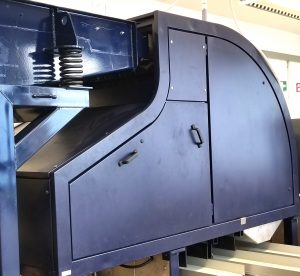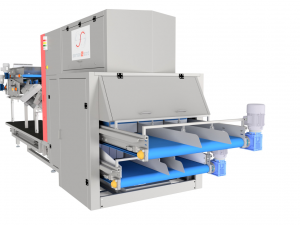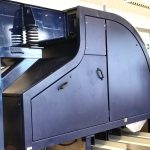The Sense to Sort. Or: Sorting makes more Sense than ever.
October 8, 2018
Opportunitites for SMEs. Sales markets for reclaimed and recycled metals change again and again, as do the associated sorting trends. The marketing of metals through small and medium-sized recycling companies is under pressure. Mostly, SMEs are looking for solutions to further optimize their source material flows without much effort or rebuilding. This applies to the metal recycler in the automotive sector, as well as to the WEEE recyclers or others who trade in recycled metals.
Improving the material quality helps to increase the selling price again.
In this article, we concentrate on the non-ferrous metals after the crushers, i.e. on the light and heavy metals such as aluminium, magnesium, zinc, copper, lead and stainless steel in a changed recycling world where China bans material fractions that were welcome before. In the US new tariffs have been imposed this year to impact the steel and aluminium industries.
Consequently, sales markets have reduced as territories have closed their doors to inferior material qualities, or changed economically. With the sales markets getting geographically smaller, and thus the supply getting bigger, recyclers have to deal with further price reduction. Improving the material quality helps to increase the selling price again.
The situation has changed: Need to upgrade Al sorting to avoid penalties for low material quality. Opportunities for SMEs.
Shredder Residue, ZORBA, ZURIK: Let us look at how sorting quality can be improved cost efficiently by SME recyclers with different investment opportunities, because sorting better requires some investments. Todays recycling facility applies different sorting technologies behind shredder and magnet. To improve sorting efficiency in metal recycling, this is where we start to look into the process—focusing only on the sorting machines in this type of plant. The essential part of this material stream called shredder residue, does not contain too many metallic components, only 5-10% is metal. These are sorted out with the first sorting step, the eddy current separators (ECS). Here, the ECS produces the so-called Zorba and Fluff material fractions.
Improving ZORBA: This mixture of light and heavy nonferrous metals, is rich in Aluminium, but this Al fraction is contaminated by the heavy metals portion such as zinc, lead, copper, brass, bronze, and stainless steel, but also PCB’s (Printed Circuit Board). The first consideration is to separate the light fraction of cast and wrought Al alloys, with some Mg alloys, from the heavies. None of the consumers of lights or heavies value the present of the other. The contaminating metals cause price deductions and thus reduce the income of the recycler. Recyclers are faced with the need to upgrade their Al fraction to avoid penalties for low quality material.
Zorba has several separation options because of different sorting opportunities. With our spectroscopy-based sorters like S2S XRF-Sense and S2S LIBS-Sense, all metal types and alloys can be analysed and sorted based on their elemental properties. Now the customer will indicate his interest in terms of required sorting qualities and material streams. For example, wrought and cast sorting and the separation of the heavies, to reduce the zinc content or recover all high Fe aluminium alloys. Zorba can be a “pure” aluminium fraction using XRF and LIBS sensor based sorting technologies. These technologies are also applied by secondary aluminium smelters directly to cost efficiently create smelt ready metal packages.
The good news is, todays sorting technologies allow the automatic sortation according to their elemental composition, thus even alloys can be classified.
For their part, secondary aluminium smelters are opting to buy lower-cost scrap and process it into melt-ready packages. This ‘greener’ process approach not only makes their raw material supply more predictable but also increases the margin on their final product. Construction material, beverage containers and, most recently, the explosive growth in aluminium usage in vehicle manufacturing are the driving forces behind this approach.
Improving ZURIK: The other post Eddy Current Separator fraction is supposed to be the waste fraction, or Fluff; at least it was called so, for many years, until the induction sorter was introduced into the European Metal Recycling market end of the last century. There is still a lot of metals to be recovered in the Fluff material stream: mainly wires and plastic coated wires, stainless steel, PCBs and a minimum amount of other non-ferrous metals, that are missed by the ECS can be recovered with induction sorters such as our S2S Metal-Sense. This extraction mixture of metal containing material is called Zurik. This machine is used for two steps in the Zurik application. First step is the stainless steel separation followed by the second step, where all wires and other metals are sorted out. The rest fraction is free of metals (>99%). The first step is getting more and more importance since stainless steel is unwanted in the copper wire fraction. The stainless steel fraction will have parts of metal rich PCBs and big copper pieces, so a quality control is needed by hand sorting or by applying our S2S-RobotSense, to automate manual sorting easily.
In addition to providing standard sorting solutions for improving sorted material qualities in recycling applications, it has been our passion to supply customized plant solutions, integrating existing sorting technologies at the customers yard and improve the process to more efficiency by redesigning the process to today’s standards, both economically and on a reduced footprint.
Sense2Sort Toratecnica, S.L. has built and serviced sensor-based sorting machinery for recycling applications all over the world. Their classic product offering is based on common sorting technologies such as Induction, CCD, NIR, XRF, LIBS and combinations thereof.
Sense2Sort has been a continuous innovator and its aim is the perfect closing of the recycling loop using latest material identification methods. Using their deep know-how and experience, Sense2Sort’s experts consult on new and existing concepts for plant improvement and sorting perfection, achieving the highest process profitability for their customers.

S2S LIBS-Sense sorter for automatic sorting of bulk metals according to their elemental composition such as Aluminum alloys

S2S 6-Sense sorter for separation of up to 6 fractions in one run
Please contact us at info@sense2sort.com and




